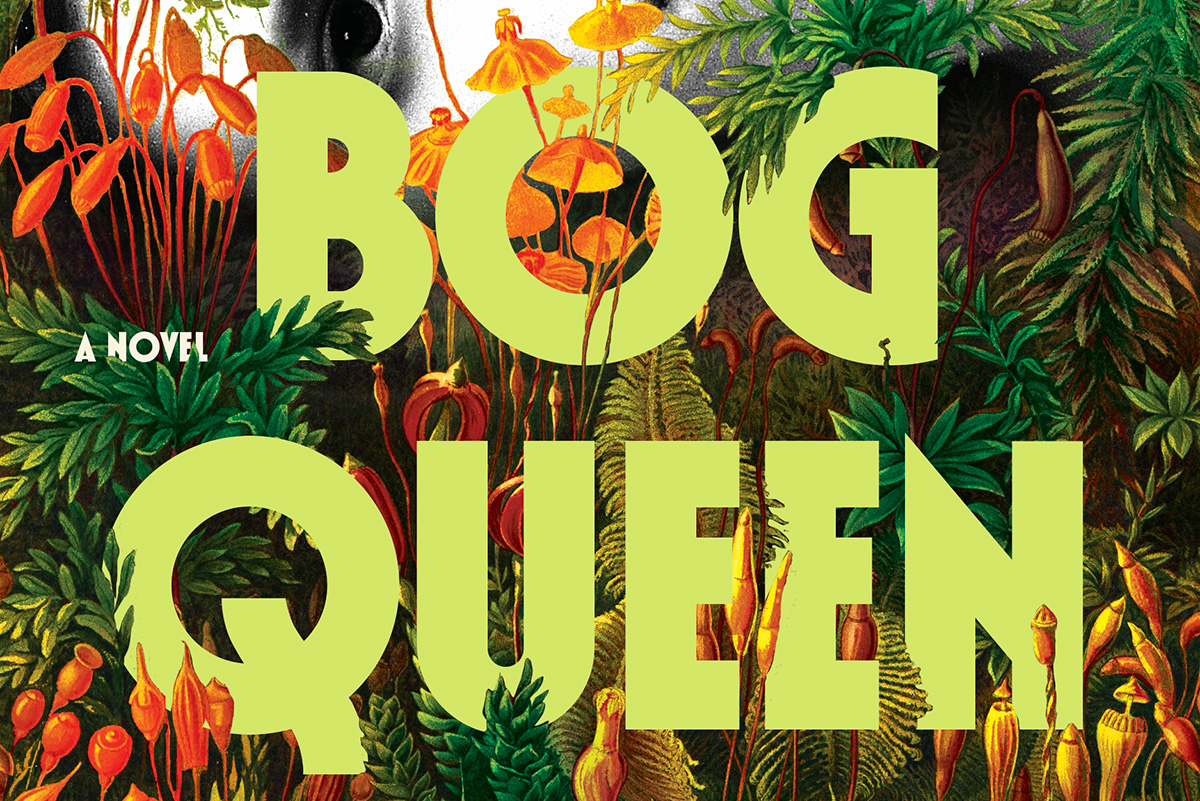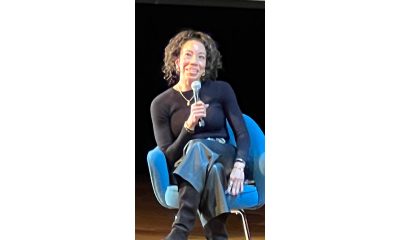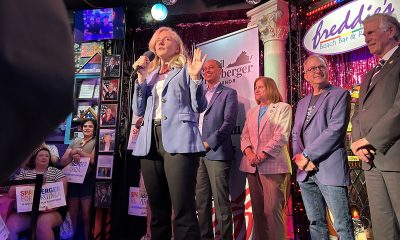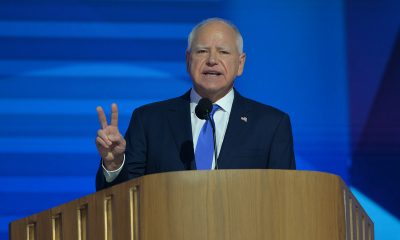Arts & Entertainment
Images and outrage
Controversy aside, ‘Hide/Seek’ is a groundbreaking show

A still from the video that caused controversy in the current "Hide/Seek" exhibit at the National Portrait Gallery.
Catcher Yogi Berra once famously called it “deja vu all over again.” But it was Karl Marx who perhaps defined it best as “when history repeats itself — the first time as tragedy, the second time as farce.”
That was the feeling at least for a moment last week, when officials at the National Portrait Gallery censored a video component of its exhibit titled “Hide/Seek,” the show about gay and lesbian sexual love and its impact on American art. Complaints by right-wing Catholics over 11 seconds of a depiction of ants crawling on a crucifix was enough for NPG director Martin E. Sullivan to decide to turn tail and yank an entire half-hour-long 1987 video, titled “A Fire in My Belly” — a meditation on the ravages of AIDS by David Wojnarowicz, the gay artist who died from HIV-related causes in 1992.
Shades of Robert Mapplethorpe and the cancellation of an exhibit of his erotically charged photos by the Corcoran Gallery of Art in 1989. And now as then GOP politicians are on the attack under the banner of “no promo homo,” and also as before, another gallery — this time Flashpoint — courageously took up the challenge and began to show the offending video.
But what about the groundbreaking NPG show itself, which opened in October and runs through mid-February? It’s stunning with 105 pieces of art from the canon of America’s greatest artists of the past century and more, depicting the ways in which their sexual orientations expressed themselves — usually coded and concealed — visually on canvas and other surfaces and as images in motion.
The exhibit is titled as a playful reminder of the childhood game of hide-and-seek, when concealment is the first task for survival. “HIDE/SEEK — Difference and Desire in American Portraiture,” with its range and breadth of seeing and finding works of art that dare speak, however sotto voce, the name of taboo love, boldly snaps in two the several decades-long taboo, welded firmly in place after the Mapplethorpe fiasco, of acknowledging same-sex desire in major U.S. museums.
The range of artists begins with Thomas Eakins and his scenes of naked boys swimming and passes through other giants of American painting — John Singer Sargent, George Bellow, Georgia O’Keefe, Jasper Johns, Robert Rauschenberg, Andy Warhol and others — to our own new century. But as co-curator Jonathan D. Katz contends, “seeking and noticing” the sexual subtexts of their work “are two very different acts,” and this exhibit “seeks to turn such seeing into noticing.”
As with their work itself, nothing is as it seems at first. Therefore, “HIDE/SEEK” features, says Katz, “straight artists representing gay figures, gay artists representing straight figures, gay artists representing gay figures, and even straight artists representing straight figures, when of interest to gay people/culture.”
For Katz, considered the dean of academic study of gay and lesbian art history, this has been the curatorial work of more than 15 years. Katz shaped this exhibit with Smithsonian historian David C. Ward, who has openly called Katz “my camerado — per Walt (Whitman).”
Ward also says that Katz, who founded the gay and lesbian studies program at Yale University and is the first tenured professor in LGBT studies in the nation, “is a model of the engaged scholar” and as a result ran afoul of academic norms in the past for his avowed interest in these subjects.
“He’s someone who managed to be thrown out of two institutions, the University of Chicago and Johns Hopkins University,” Ward says, “for daring in the 1970s to want to write about gay and lesbian Americans.”
In the magisterial catalogue accompanying the exhibit, Katz confesses that their choice of subjects is “firmly canonical” and rooted in “the register of great American artists … within the American mainstream,” so that many artists, less well known, have been excluded. The key objective, says Katz, is to show that “the assumption that same-sex desire is at best tangential to the history of American art” is “utterly unsupportable.”
With “HIDE/SEEK,” and even with the Wojnarowicz censorship fresh at hand, it now seems safe to say, in Katz’s words, that the “pervasive silencing of same-sex desire in accounts of American portrait painting” is over.
Perhaps the most interesting feature of the exhibit comes in its revelation that American artists at the turn of the 20th century could in fact be much more open about their subject matter than those of the mid-20th century in a period haunted by sexual McCarthyism and the hunt for “reds and gays” in government, the schools and the clergy. During that era only on the fringes of the entertainment world, and there not always, could different sexual proclivities find open or even closeted refuge.
In other words, same-sex desire could be expressed more freely in the arts at that earlier time “prior to the advent of ‘homosexuality’ as an available category,” says Katz, even though same-sex desire acted upon was literally a crime. But this was before an explicit “homo/hetero binary” was established as the enforced norm, he says, and before “gay” and “straight” were paired as strict opposites instead of subtle inflection points on a spectrum of the sort spelled out by Alfred Kinsey in his scale of zero to six.
Key to this transformation, Katz says, was when “sexual behavior evolve(d) into sexual identity, from what you did to what you were.” In the earlier era, after all, sexual identity was premised not on the gender of one’s sexual partner but rather on one’s own gendered role —insertive or receptive — in the sex act. As Katz notes, “it was socially acceptable to penetrate a queer” for sexual relief and as “tolerable stand-ins for women.”
Thus, Katz begins the exhibit catalogue with a searching exegesis of George Bellows’ print from 1917, “The Shower Bath,” where two naked men are depicted front and center – one thin and effeminate, looking seductively over his shoulder and thrusting his posterior provocatively at a second man, beefy of build, butch and masculine, whose towel barely conceals his sexual arousal. Opposites in every way, “they are made a pair,” says Katz, and what he calls “the odd couple” are “the focal point of this image.” But the forward homoeroticism of the Bellows print did not hamper its commercial success at the time. And Bellows himself was a man devoted to his wife and children.
There is, of course much more in this exhibit, with many works coded with layers of longing, that NPG director Sullivan — before the controversy erupted over the video — spoke of “with pride” as offering “a new lens with which to view the panorama of American life.” It is indeed, as he said earlier, “a sumptuous survey of more than a century of American portraiture,” asking “new questions and risking new interpretations.” It dares to be at once risky and risque.
With portraits such as these, we enter the lives of others, to explore how identities were forged in the past. With portraits such as these, we end up staring at ourselves.
Books
Feminist fiction fans will love ‘Bog Queen’
A wonderful tale of druids, warriors, scheming kings, and a scientist

‘Bog Queen’
By Anna North
c.2025, Bloomsbury
$28.99/288 pages
Consider: lost and found.
The first one is miserable – whatever you need or want is gone, maybe for good. The second one can be joyful, a celebration of great relief and a reminder to look in the same spot next time you need that which you first lost. Loss hurts. But as in the new novel, “Bog Queen” by Anna North, discovery isn’t always without pain.

He’d always stuck to the story.
In 1961, or so he claimed, Isabel Navarro argued with her husband, as they had many times. At one point, she stalked out. Done. Gone, but there was always doubt – and now it seemed he’d been lying for decades: when peat cutters discovered the body of a young woman near his home in northwest England, Navarro finally admitted that he’d killed Isabel and dumped her corpse into a bog.
Officials prepared to charge him.
But again, that doubt. The body, as forensic anthropologist Agnes Lundstrom discovered rather quickly, was not that of Isabel. This bog woman had nearly healed wounds and her head showed old skull fractures. Her skin glowed yellow from decaying moss that her body had steeped in. No, the corpse in the bog was not from a half-century ago.
She was roughly 2,000 years old.
But who was the woman from the bog? Knowing more about her would’ve been a nice distraction for Agnes; she’d left America to move to England, left her father and a man she might have loved once, with the hope that her life could be different. She disliked solitude but she felt awkward around people, including the environmental activists, politicians, and others surrounding the discovery of the Iron Age corpse.
Was the woman beloved? Agnes could tell that she’d obviously been well cared-for, and relatively healthy despite the injuries she’d sustained. If there were any artifacts left in the bog, Agnes would have the answers she wanted. If only Isabel’s family, the activists, and authorities could come together and grant her more time.
Fortunately, that’s what you get inside “Bog Queen”: time, spanning from the Iron Age and the story of a young, inexperienced druid who’s hoping to forge ties with a southern kingdom; to 2018, the year in which the modern portion of this book is set.
Yes, you get both.
Yes, you’ll devour them.
Taking parts of a true story, author Anna North spins a wonderful tale of druids, vengeful warriors, scheming kings, and a scientist who’s as much of a genius as she is a nerd. The tale of the two women swings back and forth between chapters and eras, mixed with female strength and twenty-first century concerns. Even better, these perfectly mixed parts are occasionally joined by a third entity that adds a delicious note of darkness, as if whatever happens can be erased in a moment.
Nah, don’t even think about resisting.
If you’re a fan of feminist fiction, science, or novels featuring kings, druids, and Celtic history, don’t wait. “Bog Queen” is your book. Look. You’ll be glad you found it.
Movies
A Shakespearean tragedy comes to life in exquisite ‘Hamnet’
Chloe Zhao’s devastating movie a touchstone for the ages

For every person who adores Shakespeare, there are probably a dozen more who wonder why.
We get it; his plays and poems, composed in a past when the predominant worldview was built around beliefs and ideologies that now feel as antiquated as the blend of poetry and prose in which he wrote them, can easily feel tied to social mores that are in direct opposition to our own, often reflecting the classist, sexist, and racist patriarchal dogma that continues to plague our world today. Why, then, should we still be so enthralled with him?
The answer to that question might be more eloquently expressed by Chloe Zhao’s “Hamnet” – now in wide release and already a winner in this year’s barely begun awards season – than through any explanation we could offer.
Adapted from the novel by Maggie O’Farrell (who co-wrote the screenplay with Zhao), it focuses its narrative on the relationship between Will Shakespeare (Paul Mescal) and his wife Agnes Hathaway (Jessie Buckley), who meet when the future playwright – working to pay off a debt for his abusive father – is still just a tutor helping the children of well-to-do families learn Latin. Enamored from afar at first sight, he woos his way into her life, and, convincing both of their families to approve the match (after she becomes pregnant with their first child), becomes her husband. More children follow – including Hamnet (Jacobi Jupe), a “surprise” twin boy to their second daughter – but, recognizing Will’s passion for writing and his frustration at being unable to follow it, Agnes encourages him to travel to London in order to immerse himself in his ambitions.
As the years go by, Agnes – aided by her mother-in-law (Emily Watson) and guided by the nature-centric pagan wisdom of her own deceased mother – raises the children while her husband, miles away, builds a successful career as the city’s most popular playwright. But when an outbreak of bubonic plague results in the death of 11-year-old Hamnet in Will’s absence, an emotional wedge is driven between them – especially when Agnes receives word that her husband’s latest play, titled “Hamlet,” an interchangeable equivalent to the name of their dead son, is about to debut on the London stage.
There is nothing, save the bare details of circumstance around the Shakespeare family, that can be called factual about the narrative told in “Hamnet.” Records of Shakespeare’s private life are sparse and short on context, largely limited to civic notations of fact – birth, marriage, and death announcements, legal documents, and other general records – that leave plenty of space in which to speculate about the personal nuance such mundane details might imply. What is known is that the Shakespeares lost their son, probably to plague, and that “Hamlet” – a play dominated by expressions of grief and existential musings about life and death – was written over the course of the next five years. Shakespearean scholars have filled in the blanks, and it’s hard to argue with their assumptions about the influence young Hamnet’s tragic death likely had over the creation of his father’s masterwork. What human being would not be haunted by such an event, and how could any artist could avoid channeling its impact into their work, not just for a time but for forever after?
In their screenplay, O’Farrell and Zhao imagine an Agnes Shakespeare (most records refer to her as “Anne” but her father’s will uses the name “Agnes”) who stands apart from the conventions of her town, born of a “wild woman” in the woods and raised in ancient traditions of mysticism and nature magic before being adopted into her well-off family, who presents a worthy match and an intellectual equal for the brilliantly passionate creator responsible for some of Western Civilization’s most enduring tales. They imagine a courtship that would have defied the customs of the time and a relationship that feels almost modern, grounded in a love and mutual respect that’s a far cry from most popular notions of what a 16th-century marriage might look like. More than that, they imagine that the devastating loss of a child – even in a time when the mortality rate for children was high – might create a rift between two parents who can only process their grief alone. And despite the fact that almost none of what O’Farrell and Zhao present to us can be seen, at best, as anything other than informed speculation, it all feels devastatingly true.
That’s the quality that “Hamnet” shares with the ever-popular Will Shakespeare; though it takes us into a past that feels as alien to us as if it took place upon a different planet, it evokes a connection to the simple experience of being human, which cuts through the differences in context. Just as the kings, heroes, and fools of Shakespeare’s plays express and embody the same emotional experiences that shape our own mundane modern lives, the film’s portrayal of these two real-life people torn apart by personal tragedy speaks directly to our own shared sense of loss – and it does so with an eloquence that, like Shakespeare’s, emerges from the story to make it feel as palpable as if their grief was our own.
Yes, the writing and direction – each bringing a powerfully feminine “voice” to the story – are key to the emotional impact of “Hamnet,” but it’s the performances of its stars that carry it to us. Mescal, once more proving himself a master at embodying the kind of vulnerable masculine tenderness that’s capable of melting our hearts, gives us an accessible Shakespeare, driven perhaps by a spark of genius yet deeply grounded in the tangible humanity that underscores the “everyman” sensibility that informs the man’s plays. But it’s Buckley’s movie, by a wide margin, and her bold, fierce, and deeply affecting performance gives voice to a powerful grief, a cry against the injustice and cruelty of what we fumblingly call “fate” that resonates deep within us and carries our own grief, over losses we’ve had and losses we know are yet to come, along with her on the journey to catharsis.
That’s the word – “catharsis” – that defines why Shakespeare (and by extension, “Hamnet”) still holds such power over the imagination of our human race all these centuries later. The circumstantial details of his stories, wrapped up in ancient ideologies that still haunt our cultural imagination, fall away in the face of the raw expression of humanity to which his characters give voice. When Hamlet asks “to be or not to be?,” he is not an old-world Danish Prince contemplating revenge against a traitor who murdered his father; he is Shakespeare himself, pondering the essential mystery of life and death, and he is us, too.
Likewise, the Agnes Shakespeare of “Hamnet” (masterfully enacted by Buckley) embodies all our own sorrows – past and future, real and imagined – and connects them to the well of human emotion from which we all must drink; it’s more powerful than we expect, and more cleansing than we imagine, and it makes Zhao’s exquisitely devastating movie into a touchstone for the ages.
We can’t presume to speak for Shakespeare, but we are pretty sure he would be pleased.

Friday, January 9
Women in Their Twenties and Thirties will be at 8 p.m. on Zoom. This is a social discussion group for queer women in the Washington, D.C. area. For more details, visit Facebook.
“Backbone Comedy” will be at 8 p.m. at As You Are. Backbone Comedy is a queer-run fundraiser comedy show at As You Are Bar DC, where comics stand up for a cause. Each show, a percentage of proceeds go to a local organization – Free Minds DC, a reentry organization for individuals impacted by incarceration. Tickets cost $19.98 and are available on Eventbrite.
Saturday, January 10
Go Gay DC will host “LGBTQ+ Community Brunch” at 11 a.m. at Freddie’s Beach Bar & Restaurant. This fun weekly event brings the DMV area LGBTQ+ community, including allies, together for delicious food and conversation. Attendance is free and more details are available on Eventbrite.
Monday, January 12
“Center Aging: Monday Coffee Klatch” will be at 10 a.m. on Zoom. This is a social hour for older LGBTQ+ adults. Guests are encouraged to bring a beverage of choice. For more information, contact Adam ([email protected]).
Genderqueer DC will be at 7 p.m. on Zoom. This is a support group for people who identify outside of the gender binary, whether you’re bigender, agender, genderfluid, or just know that you’re not 100% cis. For more details, visit genderqueerdc.org or Facebook.
Tuesday, January 13
Coming Out Discussion Group will be at 7 p.m. on Zoom. This is a safe space to share experiences about coming out and discuss topics as it relates to doing so — by sharing struggles and victories the group allows those newly coming out and who have been out for a while to learn from others. For more details, visit the group’s Facebook.
Trans Discussion Group will be at 7 p.m. on Zoom. This group is intended to provide an emotionally and physically safe space for trans people and those who may be questioning their gender identity/expression to join together in community and learn from one another. For more details, email [email protected].
Wednesday, January 14
Job Club will be at 6 p.m. on Zoom upon request. This is a weekly job support program to help job entrants and seekers, including the long-term unemployed, improve self-confidence, motivation, resilience and productivity for effective job searches and networking — allowing participants to move away from being merely “applicants” toward being “candidates.” For more information, email [email protected] or visit thedccenter.org/careers.
The DC Center for the LGBT Community will partner with House of Ruth to host “Art & Conversation” at 3 p.m. at 1827 Wiltberger St., N.W. This free workshop will involve two hours of art making, conversation, and community. Guests will explore elements of healthy relationships with a community-centered art activity. This workshop involves paint, so please dress accordingly. All materials will be provided. For more details, email [email protected].
Thursday, January 15
The DC Center’s Fresh Produce Program will be held all day at the DC Center for the LGBT Community. People will be informed on Wednesday at 5 p.m. if they are picked to receive a produce box. No proof of residency or income is required. For more information, email [email protected] or call 202-682-2245.
Virtual Yoga Class will be at 7 p.m. on Zoom. This free weekly class is a combination of yoga, breathwork and meditation that allows LGBTQ+ community members to continue their healing journey with somatic and mindfulness practices. For more details, visit the DC Center’s website.
-

 National4 days ago
National4 days agoWhat to watch for in 2026: midterms, Supreme Court, and more
-

 Colombia5 days ago
Colombia5 days agoBlade travels to Colombia after U.S. forces seize Maduro in Venezuela
-

 Virginia5 days ago
Virginia5 days agoLGBTQ groups to join Spanberger inaugural parade
-

 Minnesota5 days ago
Minnesota5 days agoTim Walz drops out of Minn. governor’s race




















